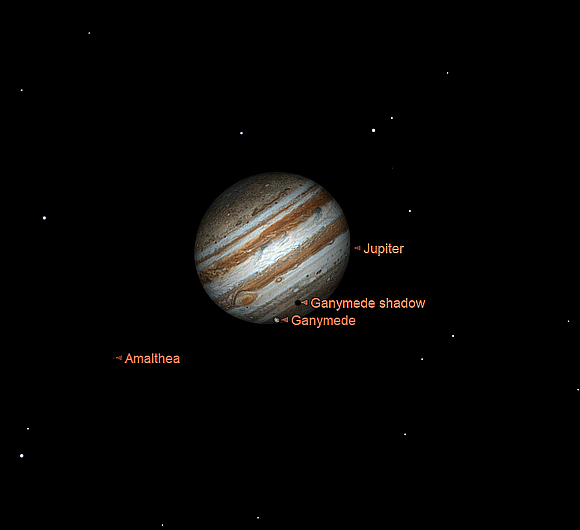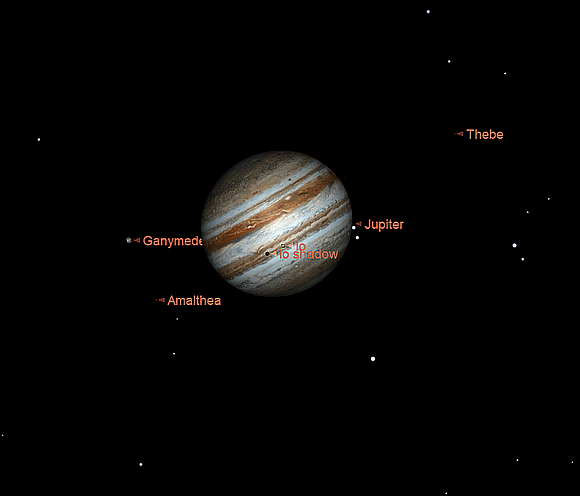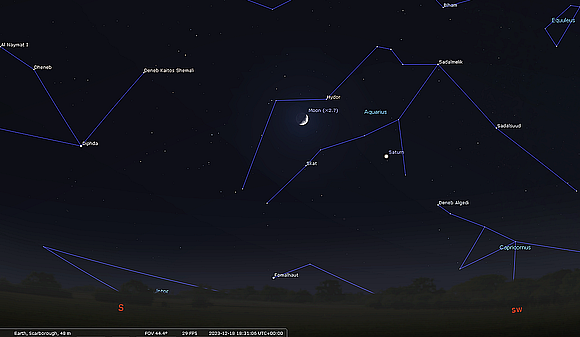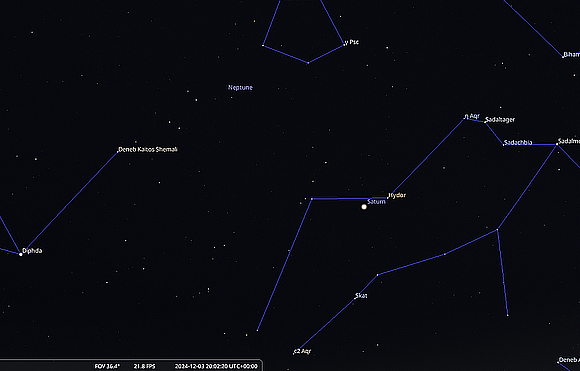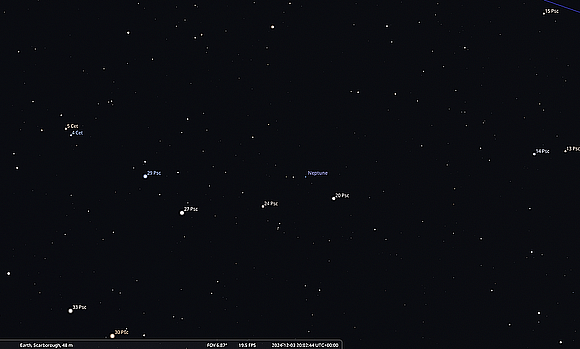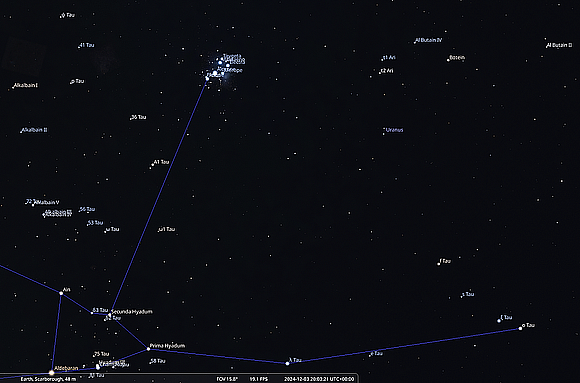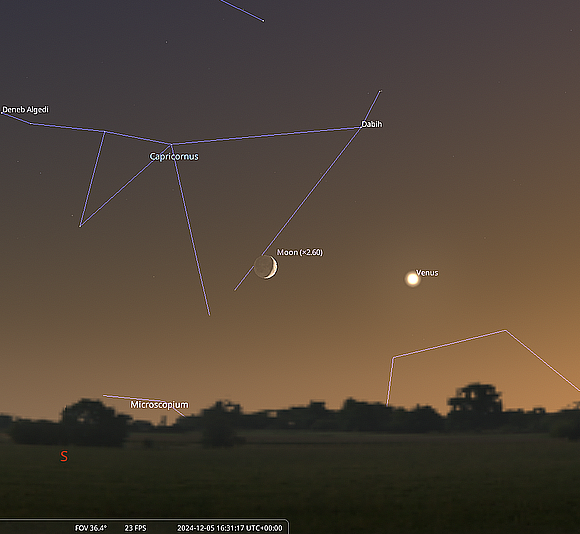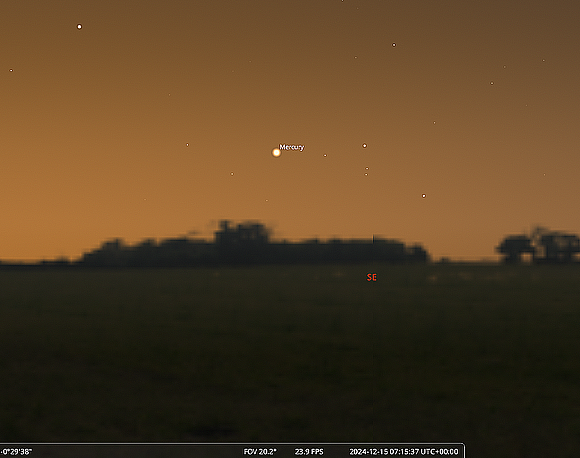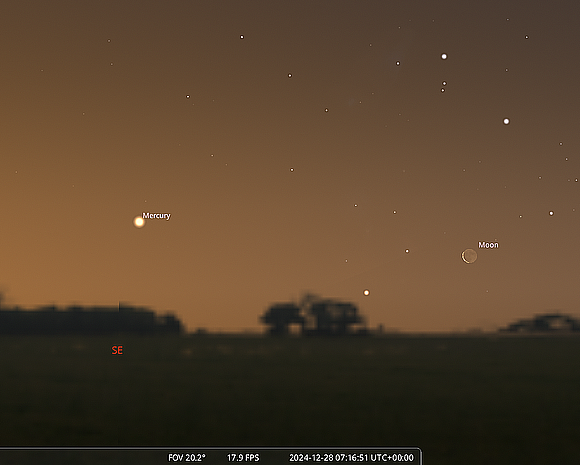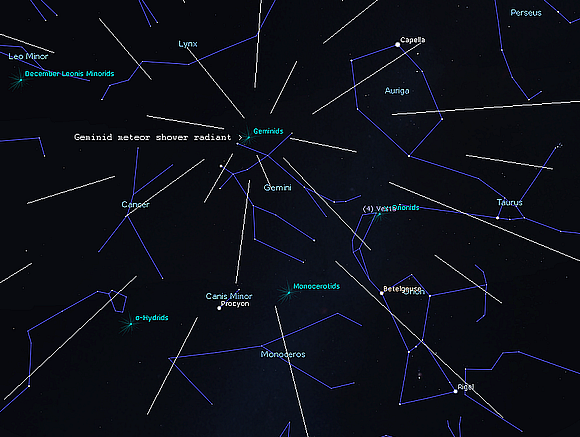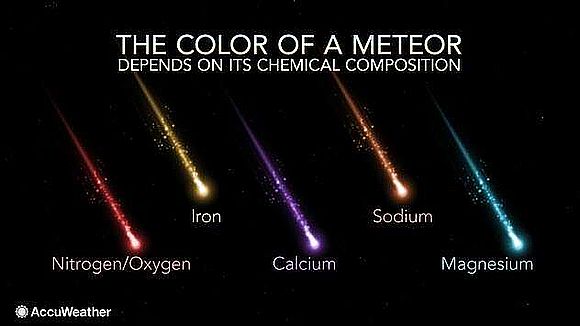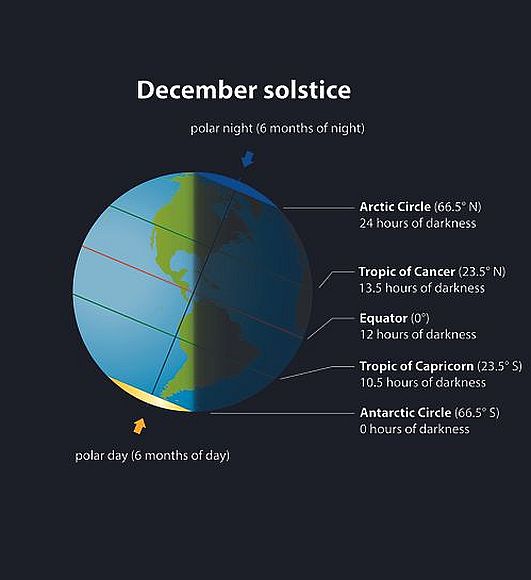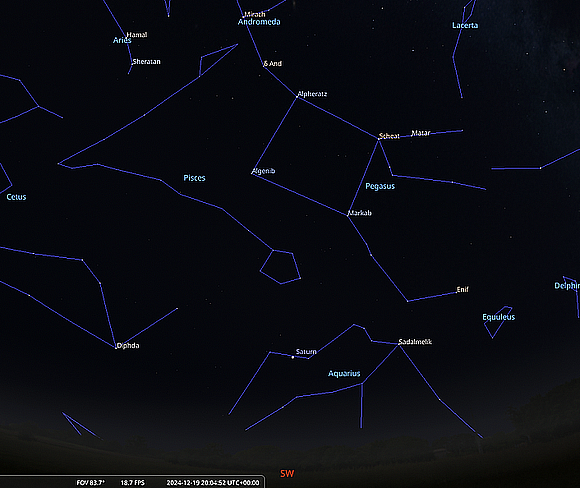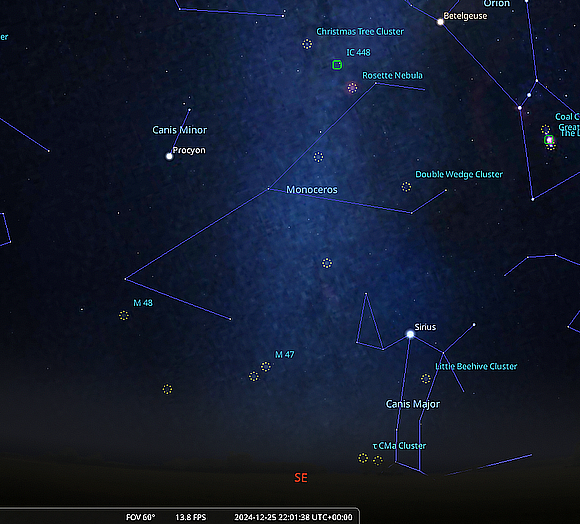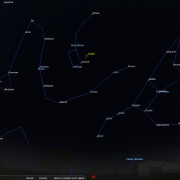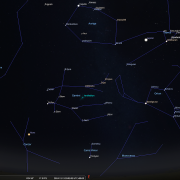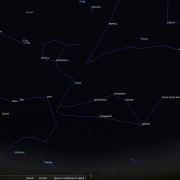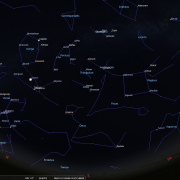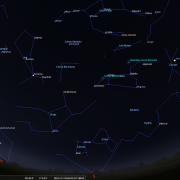In this month's Sky Notes:
- Planetary Skylights
- December Meteor - Aurora Report
- Winter Solstice
- December Night Sky
- December 2024 Sky Charts
Planetary Skylights: A Brief Guide to December's Night Sky
Venus dominates the early evening twilight sky. Jupiter dominates the rest of evening and night as it reaches opposition. Mars grows more prominent in the night sky. Saturn remains well placed for observation during the evening. Neptune and Uranus both require a telescopic aid to identify. Mercury commences a respectable morning apparition mid-month.
 Jupiter dominates the night sky reaching opposition on December 7th and therefore visible from evening twilight until dawn. Residing in the heart of Taurus the Bull, Jupiter is moving in retrograde motion - westwards, tracking back toward fiery Aldebaran, chief star in Taurus - the 'eye of the Bull'. At magnitude -2.8 Jupiter is very conspicuous riding high in the sky, culminating to the south shortly after midnight 60-degrees above the horizon, spending 10 hours above the 25-degree, unstable air, poorer seeing mark.
Jupiter dominates the night sky reaching opposition on December 7th and therefore visible from evening twilight until dawn. Residing in the heart of Taurus the Bull, Jupiter is moving in retrograde motion - westwards, tracking back toward fiery Aldebaran, chief star in Taurus - the 'eye of the Bull'. At magnitude -2.8 Jupiter is very conspicuous riding high in the sky, culminating to the south shortly after midnight 60-degrees above the horizon, spending 10 hours above the 25-degree, unstable air, poorer seeing mark.
Jupiter is always a worthy target for any sized telescope, but over the next 3 months it should be exceptional for UK observers. Viewing through the eyepiece Jupiter exhibits an oblate disk some 48 arc seconds in diameter flanked by the Galilean moons - visible as bright specks of light. The dark equatorial belts will be readily visible in instruments as small as 60mm (2.5”), mounted binoculars will even pick up the Galilean moons. Larger apertures will reveal an increasingly amount of detail, with the less evident polar regions and finer northern and southern temperate belts becoming more noticeable. When turned in our direction look for the great red spot (GRS) feature a colossal hurricane type storm, which in recent decades has diminished in size by a third and grown paler in hue.
The GRS can be observed in 100mm (4”) scopes but will be more obvious with 150mm (6”) instruments at medium powers. Look for the GRS on Dec 1st, 4th, 6th, 11th, 16th, 18th, 21st, 23rd, 28th, and 30th from 18:00 - 20:00hrs GMT.
The Galilean moons, Jupiter's four large satellites are fascinating to follow, the configuration of which constantly changes as they orbit around Jupiter. The inner 3 Galilean moons are in a 1:2:4 orbital resonance, Io orbits in 1.8 days, Europa in 3.6, Ganymede in 7.2 days. At 16.7 days Callisto is not quite in resonance but will become so in the future. Because of this resonance the observer enjoys a different pattern of moons each night, and in fact can discern a shift in their positions relative to one another over the course of just an hour or so. (especially when they are in proximity). The moons also provide shadow transits as the moon sweep in front of Jupiter’s disk. Look for following favourable Galilean moon shadow transits (visible as black dots on the disk) on the following dates, Ganymede - Dec 1st around 19:30hrs, Europa - Dec 16th @ 19:30hrs and Io – Dec 19th @ 19:30hrs GMT. A full Moon lies above Jupiter on Dec 14th.
 Mars becomes ever more noticeable over the course of month rising by 20:00hrs GMT at the start and before 18:00hrs at the end. The Red Planet is now in retrograde motion moving westwards against the background stars of Gemini below, and back toward the 'twins' leading stars, Castor and Pollux. Over the course of December Mars brightens considerably from magnitude -0.5 at the start to mag -1.2 by the end of the month. The good news for observers is that by late evening Mars rides well clear of unstable 'seeing' normally present below the 30-degree elevation mark remaining above this altitude for over 7 hours in duration.
Mars becomes ever more noticeable over the course of month rising by 20:00hrs GMT at the start and before 18:00hrs at the end. The Red Planet is now in retrograde motion moving westwards against the background stars of Gemini below, and back toward the 'twins' leading stars, Castor and Pollux. Over the course of December Mars brightens considerably from magnitude -0.5 at the start to mag -1.2 by the end of the month. The good news for observers is that by late evening Mars rides well clear of unstable 'seeing' normally present below the 30-degree elevation mark remaining above this altitude for over 7 hours in duration.
In the eyepiece, the Martian disk is improving in size, reaching a respectable 14.5 arc-seconds by the end of the month, but still only a third the size of Jupiter's. With steady seeing, instruments of say 100mm using medium magnification should reveal some surface detail - including the polar cap, and darker 'fin' shape of Syrtis Major, visible the first few days of The Moon lies in the vicinity of Mars on Dec 18th.In the eyepiece, the Martian disk is improving in size, reaching a respectable 14.5 arc-seconds by the end of the month, but still only a third the size of Jupiter's. With steady seeing, instruments of say 100mm using medium magnification should reveal some surface detail - including the polar cap, and darker 'fin' shape of Syrtis Major, visible the first few days of The Moon lies in the vicinity of Mars on Dec 18th.
 Saturn remains a viable object throughout December evenings in the S/SE but is setting before 21:30hrs by the new year from UK latitudes. At magnitude +0.9, Saturn is reasonably conspicuous amongst the faint stars of Aquarius - some distance below the 'water jar' asterism. It is located to the SSW as dusk falls in early December a respectable 21+ degrees above the horizon from the UK, but still short of the celestial equator. We are a couple of years away still from Saturn crossing this unseen boundary, making it into the northern hemisphere of the sky, better placed for UK observers.
Saturn remains a viable object throughout December evenings in the S/SE but is setting before 21:30hrs by the new year from UK latitudes. At magnitude +0.9, Saturn is reasonably conspicuous amongst the faint stars of Aquarius - some distance below the 'water jar' asterism. It is located to the SSW as dusk falls in early December a respectable 21+ degrees above the horizon from the UK, but still short of the celestial equator. We are a couple of years away still from Saturn crossing this unseen boundary, making it into the northern hemisphere of the sky, better placed for UK observers.
Through the eyepiece Saturn is normally a splendid sight, however the rings are now less than 4 degrees in tilt as we head toward the next ring plane crossing event in March 2025, so the appearance may be unfamiliar to some observers. Note Saturn's largest moon, Titan, visible as a bright speck nearby the disk. Several more moons should become visible in apertures over 150mm as the rings close further, including Rhea, Tethys and Dione. Iapetus is more likely to be glimpsed in instruments above 200mm (8"). Saturn lies closest to our Moon on Dec 8th.
 Neptune remains on show for telescopic observation throughout December evenings approximately 14 degrees northeast of Saturn. It may be tracked down below the faint loop of stars marking the western fish of Pisces - in particular lambda Piscium (mag 4.5). The nearest 'bright' stars are the chain of 5th magnitude stars 20, 24, 27 & 29 Piscium a degree to the right of Neptune. Neptune itself is at 7th magnitude appearing as a tiny 2.4 arc-second disc through the eyepiece. You will require at least a 100mm (4") aperture at 100x magnification to glimpse this, but unless 'seeing' is extremely steady an aperture of 150mm (6”) and medium/high magnification is required to clearly define it. It is possible to spot Neptune in a humble pair of binoculars, but the observer will require good sky knowledge of the location in the sky.
Neptune remains on show for telescopic observation throughout December evenings approximately 14 degrees northeast of Saturn. It may be tracked down below the faint loop of stars marking the western fish of Pisces - in particular lambda Piscium (mag 4.5). The nearest 'bright' stars are the chain of 5th magnitude stars 20, 24, 27 & 29 Piscium a degree to the right of Neptune. Neptune itself is at 7th magnitude appearing as a tiny 2.4 arc-second disc through the eyepiece. You will require at least a 100mm (4") aperture at 100x magnification to glimpse this, but unless 'seeing' is extremely steady an aperture of 150mm (6”) and medium/high magnification is required to clearly define it. It is possible to spot Neptune in a humble pair of binoculars, but the observer will require good sky knowledge of the location in the sky.
 Uranus is well placed to track down having come to opposition last month. It lies approximately 5 degrees lower right of the Pleiades star cluster in Taurus the Bull. At mag +5.6 Uranus is technically visible to the naked eye from a dark location with use of a star chart or sky app to aid. Binoculars will show it as a speck, but apertures of 80mm plus (3"+) are required to spot the tiny 3.7-degree grey-green disk. Instruments above 150mm (6") will clearly reveal it. The nearby pairing of 13 and 14 Tau (both 5th magnitude stars) lay one degree to the left. Culminating before midnight some 53 degrees above the south horizon, Uranus is a viable observing object until 04:30hrs GMT.
Uranus is well placed to track down having come to opposition last month. It lies approximately 5 degrees lower right of the Pleiades star cluster in Taurus the Bull. At mag +5.6 Uranus is technically visible to the naked eye from a dark location with use of a star chart or sky app to aid. Binoculars will show it as a speck, but apertures of 80mm plus (3"+) are required to spot the tiny 3.7-degree grey-green disk. Instruments above 150mm (6") will clearly reveal it. The nearby pairing of 13 and 14 Tau (both 5th magnitude stars) lay one degree to the left. Culminating before midnight some 53 degrees above the south horizon, Uranus is a viable observing object until 04:30hrs GMT.
 As we head through December Venus becomes ever more noticeable as evening twilight descends increasing in brightness to a dazzling magnitude -4.36. The 'evening star' also climbs to a respectable 22-25 degrees elevation by the start of the new year (depending how far north or south you are in the UK). Venus will certainly attract the eye by Christmas residing over in the southwest aspect of the sky. Venus is approaching Earth in its orbit, its disk size increasing from 14 to 22 arc-seconds during December, with the phase illumination diminishing from 65% to 55% at the same time.
As we head through December Venus becomes ever more noticeable as evening twilight descends increasing in brightness to a dazzling magnitude -4.36. The 'evening star' also climbs to a respectable 22-25 degrees elevation by the start of the new year (depending how far north or south you are in the UK). Venus will certainly attract the eye by Christmas residing over in the southwest aspect of the sky. Venus is approaching Earth in its orbit, its disk size increasing from 14 to 22 arc-seconds during December, with the phase illumination diminishing from 65% to 55% at the same time.
In a dark sky Venus can appear over-dazzling through the eyepiece and is best appreciated in twilight, although apart from a phase little else will be discerned, perhaps some subtle shading. On Dec 4th a thin crescent Moon sits below Venus just above the SW horizon, view around 16:30hrs. As we head into the New Year Venus is heading in the direction of Saturn for a close encounter mid-January.
 Mercury commences a respectable early morning apparition in December lasting into first week of January. The innermost planet can be tracked down low to the southeast horizon from the 12th onwards viewing shortly after 07:00hrs. At magnitude -0.1 Mercury should be readily apparent in binoculars a few degrees above the horizon, and once located should then be picked up by the naked eye. By the end of the month Mercury will have brightened to -0.35, but will be more challenging to spot hugging the SE horizon around 07:15hrs.
Mercury commences a respectable early morning apparition in December lasting into first week of January. The innermost planet can be tracked down low to the southeast horizon from the 12th onwards viewing shortly after 07:00hrs. At magnitude -0.1 Mercury should be readily apparent in binoculars a few degrees above the horizon, and once located should then be picked up by the naked eye. By the end of the month Mercury will have brightened to -0.35, but will be more challenging to spot hugging the SE horizon around 07:15hrs.
There will be little to observe through a telescope, although an observer may distinguish the phase of this small world, 45% illuminated at the start of the apparition and 65% by the end. On December 28th a very slim crescent Moon lies well to the right of Mercury.
December Meteors - Aurora Reports
Meteor activity reaches a peak at this time of year as two major meteor showers occur within the space of 20 days with a lesser shower sandwiched in between. From almost mid-December to the first week in January, given a clear sky during the hours of darkness the chances of spotting a few shooting stars are relatively high! First up are the Geminids, considered to be the most prolific and reliable annual meteor shower.
The Geminids are active from December 7-16, reaching a peak this year on December 13th (the actual predicted peak is for 21:00hrs UT). Geminid debris stems from a small asteroid called Phaethon which may even be the nucleus of a ‘dead’ comet. During a perihelion passage, Phaethon passes within ten million miles of the Sun causing the object to deposit material over great swathes of the inner solar system. It is only within the second half of the 20th century that Geminid activity has increased to the levels now recorded, a result of Earth passing through a denser debris strand, a situation that will continue only for another hundred years or so.
The shower radiant lies close to Castor, in Gemini, visible in the east by 18:00hrs. Under ideal conditions the Zenith Hourly Rate (ZHR) exceeds 120; however, observed rates are always lower. A typical Geminid meteoroid is about the size of a large coffee granule, entering the Earth’s atmosphere at speeds of 35km/s, less swift than Perseids. Brighter Geminids regularly produce long luminous trails, sometimes quite colourful. Colours in meteors usually originate from ionized elements released as the meteor disintegrates, with blue-green typically originating from magnesium, calcium radiating violet, and nickel glowing green. Red, however, typically originates from energised nitrogen and oxygen in the Earth’s atmosphere.
Prospects for the 2024 shower are not as conducive as last year with moonlight from an almost full Moon (due on the 15th) washing out fainter examples. Observed rates will peak in the early morning hours of the 14th, (morning hours are always the best - unfortunately!) An observer would then normally expect to spot 40 - 60 meteors per hour, but this year only the brighter examples will be visible, perhaps 10-15per hour. Viewing late evening of the 13th, when the shower radiant is lower to the east horizon will yield still fewer meteors - perhaps a dozen from 21:00hrs to midnight. The evening hours are however the best time to try and catch an 'earth grazer', bright, slow moving, long duration meteors that travel horizontally across the sky. Earth grazers are rare but prove to be especially memorable, if you should be lucky enough to witness one.
Conditions for the less prolific Ursid meteor shower are more favourable with a waning Quarter Moon visible only. The shower is active from Dec 17-25th, peaking this year in the early morning hours of Dec 22nd. Hourly rates of around 10 - 12 are the norm, but occasionally and erratically, Ursids can produce strong outbursts. The radiant lies close to Kockab in Ursa Minor - the Little Bear. Moonlight will interfere slightly late on the 21st and into the early morning hours of the 22nd.
Finally, although not in December, the second major meteor shower within the space of 20 days peaks in early January - the Quadrantids. Peak night will be Jan 3/4th and can produce rates upwards of 100 or more. There will be no moonlight to interfere this time - but we cannot vouch for the weather at this time of year! More on this shower next month.
There has been less aurora activity this last month with visible aurora displays tending to be seen further north. Those displays likely to have been visible from UK latitudes have predominantly coincided with daylight, behind cloud, or in full Moonlight! Be patient, plenty of time for further action me thinks - just keep tabs on aurora alerts and the north sky.
The Winter Solstice
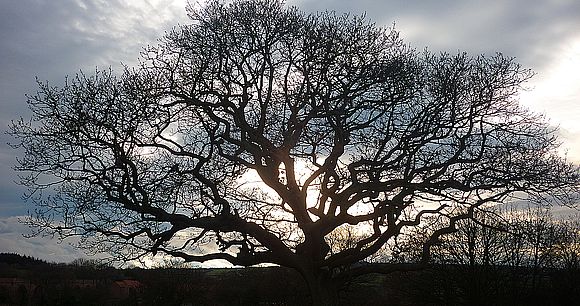
The Winter Solstice falls on December 21st in the northern hemisphere this year, the date marking the Sun's lowest position in the sky. The tilt of the northern hemisphere away from the Sun has now reached its maximum and useful daylight is at a minimum, barely 7 ½ hrs from the latitude of Whitby - the shortest day, the Sun appearing just over 12 degrees above S horizon at local noon. Latest sunrise and earliest sunset however do not occur on this date. The Sun rises latest around Dec 28th but sets earliest mid-month. Astronomical winter commences for the Northern Hemisphere, but conversely days will slowly start to lengthen again. Cause for a celebration?
The significance of the Winter Solstice to our ancestors was probably due to the fact it did mark the start of the lengthening of days, a cause for ritual celebrations associated in their eyes with the death and rebirth of the Sun.
There are many Winter Solstice festivals and celebrations in the northern hemisphere. The celebration we enjoy (or endure dependant on your view of modern day Christmas) the Christian celebration of Christmas did not become a major festival until the 9th century, although the date of December 25 was pioneered by the Roman Emperor Constantine as far back as 336 A.D, perhaps to weaken established pagan celebrations that occurred around the Winter Solstice, remnants of which remain. Happy Winter Solstice everyone!
December Night Sky
Seasonal autumnal constellations may still occupy the night sky centre stage, but as Earth spins silently toward a date with the winter solstice and the onset of astronomical winter proper, winter groups are already creeping in from the wings - at least the eastern one. Shortly, the focus of attention will be directed toward this brilliant ensemble of stellar jewels, however, before it is, we should look at the bigger celestial picture starting to the North.
Here we find most of the circumpolar groups located - those that do not set from this latitude. Included amongst these are the two bears: Ursa Major and Minor. The Plough, the familiar ‘saucepan’ asterism, which is part of Ursa Major, prowls his territory low above N horizon. Above the Plough during early mid evening stands Ursa Minor in which the Pole star, Polaris resides (the 'pointer stars' in the bowl of the Plough - Dubhe and Merak can be utilised to locate it). The celestial dragon – Draco winds its way between the bears towards the NNW where its head is marked by an irregular quadrilateral of stars.
At the same altitude a little further west of this asterism, the sparkling steely blue lustre of Vega in Lyra catches the eye. Nearby the stars of Cygnus hang, crucifix form below its chief star Deneb above the WNW horizon. Both Deneb and Vega form part of the summer triangle, the third member may be glimpsed just above the west horizon before 21:00hrs - Altair in Aquila the Eagle, the only member of the summer triangle to depart our skies.
Throughout the early part of the evening the zenith, the location directly overhead, is occupied in turn by the distinctive ‘W’ pattern of Queen Cassiopeia, then Perseus - the outline of which resemble a distorted figure Pi symbol, and later in the night the stars of Auriga the charioteer, highlighted by brilliant Capella.
The autumn skies most useful signpost group; the great square of Pegasus, initially occupies the higher region due south during early evening below which reside the less conspicuous constellations of Pisces and Aquarius. Cetus the whale churns along the south horizon below Pisces; use the front two stars in the square to locate its brightest star, Diphda. The most famed object in Cetus however is the variable star omicron Ceti - otherwise known as Mira 'the wonderful', an extraordinary pulsating red super giant up to 300 million miles in diameter.
Capricornus occupies the SSW horizon, departing early evening skies by mid-month. Try to spot conspicuous Fomalhaut in Pisces Austrinus, visible just above the SW horizon during early/mid evening until around 20:00hrs. It is the most southerly of first magnitude stars to rise over UK mainland shores. Scheat and Markab in the square of Pegasus point down to it during the first week in December.
Searing blue/white Rigel illuminates the bottom right of the rectangle, a star of spectral class B7 that is perhaps 60 – 75,000 times more luminous than our Sun. The top left corner is occupied by Betelgeuse, a red super-giant star of deep orange hue, an indication of its age and cooler temperature. Rigel is massive enough to end its days as a supernova millions of years in the future, a lifespan short by stellar standards. Of all the naked eye stars visible in the night sky, astronomers consider Betelgeuse the strongest candidate to go supernova first, perhaps in less than 10-20 thousand years. Betelgeuse has already ballooned to gargantuan proportions, over 400 million miles in diameter. Put another way, if Betelgeuse were at the heart of our solar system its surface would extend out beyond the orbit of Mars!
Bearing down on Orion's right shoulder is Taurus the Bull home to the open star clusters, the Pleiades, and the Hyades. Prominent ruddy Aldebaran - “the eye of the bull’ is the most conspicuous presence in the Hyades, a ‘V’ or arrowhead arrangement of stars, though it is not a genuine member, lying at half the distance of true members. Jupiter currently resides in Taurus to the left of Aldebaran. A little further west, upper right of the Hyades, the Pleiades star cluster (Seven Sisters) is a beautiful sight in binoculars or very low telescopic powers and is one of the most youthful star clusters visible. Keen sighted observers can make out more than seven stars with the naked eye, although most people see five or six. Binoculars, or very low telescopic magnifications reveal dozens, and the entire cluster contains over 380 members approximately 400 light years away.
Upper left of Orion stands the Twins of Gemini, marked by the two conspicuous stars, Castor, and Pollux. Castor, the most northerly of the pair, is slightly fainter than twin brother Pollux which shines with a pale amber lustre. Although Castor appears solitary, it is a multiple sextuplet system of which the brightest two components may be separated in a modest scope, given stable atmospheric conditions.
As we head through December the two hunting dogs of Orion which accompany the hunter, Canis Major and Canis Minor, dutifully following their master across the heavens. The belt stars point down in the general direction of the most prominent of all night stars, sparkling Sirius, the Dog star in Canis Major seen low to the SE. Some distance above and left, solitary Procyon, in the lesser dog of Canis Minor, is yet another highly conspicuous winter jewel, the prominence of both stars primarily due to proximity; 8.6 and 11 light years respectively. The dog’s quarry, the timid celestial hare of Lepus, may be traced crouching below Orion and above the southern horizon. Look for the faint glow of the winter Milky Way which passes down to the left of Orion, separating the two dogs on opposing banks.
Finally, although astronomical winter may have just commenced, the first celestial shoots of Spring are already sprouting from the eastern horizon - late evening. The faint stars of Cancer lead the way, which scuttle after Gemini. Leo the lion follows, best identified by the ‘Sickle’ asterism at the foot of which shines bright Regulus. The faint, but distinctive head of Hydra sits below Procyon, the rest of the snake gradually slithering above the horizon, but not until the early hours of the morning!
The first celestial shoots of spring - late December - east horizon - 22:00hrs.
(Click for full chart)
No matter whether you are an experienced observer, or perhaps have just acquired a pair of binoculars or a telescope, the jewels of Orion and his retinue are a joy to explore time and time again. Wrap up warm, find somewhere dark and enjoy!
December Sky Charts
Additional Image Credits:
- Planets and Comets where not otherwise mentioned: NASA
- Sky Charts: Stellarium Software and Starry Night Pro Plus 8
- Log in to post comments


